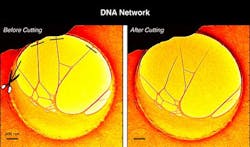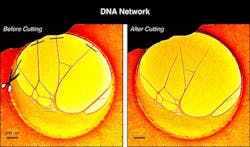Femtosecond laser boosts 4D electron microscopy images of biological networks
Scientists at the California Institute of Technology (Caltech; Pasadena, CA) have developed a technique that pairs 4D electron microscopy with heat from a femtosecond laser to visualize the behavior of biological nanostructures in both space and time. Led by Nobel Laureate Ahmed Zewail, the Linus Pauling Professor of Chemistry and professor of physics at Caltech, who co-authored the paper with Ulrich Lorenz, a postdoctoral scholar in Zewail's laboratory, the work allowed them to directly measure stiffness and map its variation throughout the network.
Knowing the mechanical properties of DNA structures is crucial to building sturdy biological networks, among other applications. According to Zewail, this type of visualization of biomechanics in space and time should be applicable to the study of other biological nanomaterials, including the abnormal protein assemblies that underlie diseases like Alzheimer's and Parkinson's.
Zewail and Lorenz were able to see, for the first time, the motion of DNA nanostructures in both space and time using the 4D electron microscope developed at Caltech's Physical Biology Center for Ultrafast Science and Technology. The center is directed by Zewail, who created it in 2005 to advance understanding of the fundamental physics of chemical and biological behavior.
"In nature, the behavior of matter is determined by its structureâthe arrangements of its atoms in the three dimensions of spaceâand by how the structure changes with time, the fourth dimension," explains Zewail. "If you watch a horse gallop in slow motion, you can follow the time of the gallops, and you can see in detail what, for example, each leg is doing over time. When we get to the nanometer scale, that is a different storyâwe need to improve the spatial resolution to a billion times that of the horse in order to visualize what is happening."
Zewail was awarded the 1999 Nobel Prize in Chemistry for his development of femtochemistry, which uses ultrashort laser flashes to observe fundamental chemical reactions occurring at the timescale of the femtosecond (one millionth of a billionth of a second). Although femtochemistry can capture atoms and molecules in motion, giving the time dimension, it cannot concurrently show the dimensions of space, and thus the structure of the material. This is because it utilizes laser light with wavelengths that far exceed the dimension of a nanostructure, making it impossible to resolve and image nanoscale details in tiny physical structures such as DNA.
To overcome this major hurdle, the 4D electron microscope employs a stream of individual electrons that scatter off objects to produce an image. The electrons are accelerated to wavelengths of picometers, or trillionths of a meter, providing the capability for visualizing the structure in space with a resolution a thousand times higher than that of a nanostructure, and with a time resolution of femtoseconds or longer.
The experiments outlined in their paper began with a structure created by stretching DNA over a hole embedded in a thin carbon film. Using the electrons in the microscope, several DNA filaments were cut away from the carbon film so that a three-dimensional, free-standing structure was achieved under the 4D microscope.
Next, the scientists employed laser heat to excite oscillations in the DNA structure, which were imaged using the electron pulses as a function of timeâthe fourth dimension. By observing the frequency and amplitude of these oscillations, a direct measure of stiffness was made.
"It was surprising that we could do this with a complex network," says Zewail. "And yet by cutting and probing, we could go into a selective area of the network and find out about its behavior and properties."
Using 4D electron microscopy, Zewail's group has begun to visualize protein assemblies called amyloids, which are believed to play a role in many neurodegenerative diseases, and they are continuing their investigation of the biomechanical properties of these networks. He says that this technique has the potential for broad applications not only to biological assemblies, but also in the materials science of nanostructures.
Full details of the work appear in the Proceedings of the National Academy of Sciences (PNAS); for more information, please visit http://www.pnas.org/content/early/2013/02/01/1300630110.abstract?sid=6375db32-72fc-4619-b04f-e1f1c88fb1c8.
-----
Follow us on Twitter, 'like' us on Facebook, and join our group on LinkedIn
Subscribe now to BioOptics World magazine; it's free!

